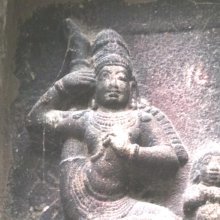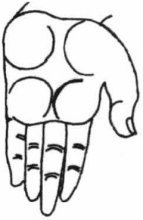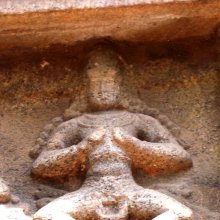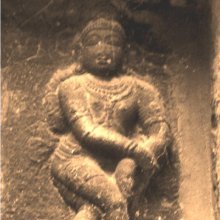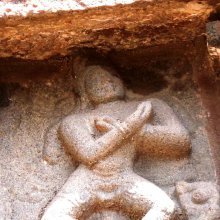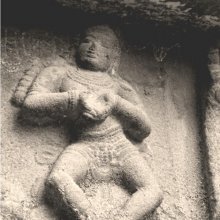Pataka, Patākā, Paṭāka, Patāka, Pātaka, Pāṭaka, Paṭaka, Paṭākā: 36 definitions
Introduction:
Pataka means something in Buddhism, Pali, Hinduism, Sanskrit, the history of ancient India, Marathi, Hindi, biology, Tamil. If you want to know the exact meaning, history, etymology or English translation of this term then check out the descriptions on this page. Add your comment or reference to a book if you want to contribute to this summary article.
Alternative spellings of this word include Patak.
Images (photo gallery)
(+20 more images available)
In Hinduism
Natyashastra (theatrics and dramaturgy)
Source: Wisdom Library: Nāṭya-śāstra1) Patāka (पताक, “flag”) refers to a gesture (āṅgika) made with a ‘single hand’ (asaṃyuta), according to the Nāṭyaśāstra chapter 8. The hands (hasta) form a part of the human body which represents one of the six major limbs (aṅga) used in dramatic performance. With these limbs are made the various gestures (āṅgika), which form a part of the histrionic representation (abhinaya).
(Instructions of Patāka): The fingers extended and close against one another, and the thumb bent.
(Uses of Patāka): To represent an administration of blows, scorching heat, urging, attainment of happiness and arrogant reference of one’s ownself this hand is to be raised on a level with the forehead. To represent the glare of heat, torrential rain and shower of flowers two Patāka hands with the fingers separated and moving, are to be joined together. A shallow pool of water, present of flowers, grass and any design [lit. object] made on the ground are to be represented by two such hands separated from the Svastika position. The same Patāka hands with their fingers pointing downwards are to be used to represent anything closed, made open, protected, covered, dense or private (to be concealed)
2) Patākā (पताका, “episode”) refers to one of the “five elements of the plot” (arthaprakṛti), according to the Nāṭyaśāstra chapter 21. These five elements represents the five means of attaining objects of the Plot (itivṛtta or vastu).—The event which is introduced in the interest of the Principal Plot and is treated like it, is called an Episode (patākā).
The associated ‘stage of action’ (avasthā) of patākā is the prārambha (beginning). These stages represent a Hero’s striving towards the object in a dramatic playwright (nāṭaka).
Source: archive.org: The mirror of gesture (abhinaya-darpana)One of the Twenty-eight Single Hands (hasta):—Patāka (flag): the thumb bent to touch the fingers, and the fingers extended. Usage: beginning a dance, cloud, forest, forbidding things, bosom, night, river, world of the gods, horse, cutting, wind, reclining, walking, prowess, graciousness, moonlight, strong sunlight, knocking, meaning of the seven cases, wave, entering a street, equahty, applying sandal paste, one’s self, taking an oath, silence, benediction, a good king, palmyraleaf, slap, touching, saying “Such and such”, the sea, the wayof good deeds, addressing (a person some distance away), goingin front, the form of a sword, month, year, rainy season, day, sprinkling water.
According to another book, the thumb is bent against the baseof the forefinger and the palm and fingers extended. When Brahmā, the Shaper, went to Parabrahmā, as he saluted him with the cry of “Victory!” he held his hand like a flag, since when it has been called the “flag hand”. It is the first of all hands, it originates from Brahmā, its colour is white, its sage Śiva, its race Brāhmaṇa, its patron deity Parabrahmā. Usage:saying “Victory, victory!”, clouds, forbidding things, forest, night, saying “Go!”, going, conveyance, wind, chest, front, merit (puṇya), preëminence, flow, abode of the wise, crying “Ha! ha!”, moonlight, sunlight, abode of the gods, removal of hindrance, wall, cutting, pleasing others, cheek, applying sandal paste, mustering an army, boundary, removing fear, having no refuge, decrease, covering, reclining, the earth, flame, pouring rain, wave, wings of a bird, petitioning a king, saying “Thus”, eye, saying “Like what?” and “Like that”, slap, touching, lake, massage, closing a dispute, strong wind, end of the robe (ancala), cold, heat, radiance, shadow, ear, season, half-year, day, fortnight, month, purity, high birth, approach,saying “Protect”, or “Caress”, Brāhmaṇa caste, pure colour.
Note: The Patāka hand is commonly seen in the abhaya-mudrā of images, but is sometimes replaced by ardha-candra.
Source: Shodhganga: Elements of Art and Architecture in the Trtiyakhanda of the Visnudharmottarapurana (natya)Patāka (पताक) refers to one of the twenty-two Asaṃyuktahastas or “single hand gestures” (in Indian Dramas), according to the Viṣṇudharmottarapurāṇa, an ancient Sanskrit text which (being encyclopedic in nature) deals with a variety of cultural topics such as arts, architecture, music, grammar and astronomy.—The hasta-mudrās (lit. “hand-gestures”) are very essential to denote some particular action or state in dancing and these mudrās are formed with the help of hands and fingers.—The word patāka indicates dhvaja in Sanskrit which means flag or banner. According to the Viṣṇudharmottarapurāṇa in patāka-hasta, all the fingers are straightened and thumb is bent. Abhinavagupta comments in the Abhinavabhāratī that this hand posture is looked like a flag and that is why it is named as patāka. The Viṣṇudharmottarapurāṇa states that the dancer uses the patāka-hasta to obstruct prahāra i.e., strike or beat in a Dance performance. Moreover, to show the blowing of wind and raining, this hand posture is used in Dance. Sometimes eagerness is also denoted with this hand posture.
In the Abhinayadarpaṇa, it is said that the patāka-hasta is used to denote the beginning of a drama. Moreover, this hand posture is used to symbolize some natural phenomenon like cloud, forest, bosom, river, wind etc.

Natyashastra (नाट्यशास्त्र, nāṭyaśāstra) refers to both the ancient Indian tradition (shastra) of performing arts, (natya—theatrics, drama, dance, music), as well as the name of a Sanskrit work dealing with these subjects. It also teaches the rules for composing Dramatic plays (nataka), construction and performance of Theater, and Poetic works (kavya).
Shaivism (Shaiva philosophy)
Source: Wisdom Library: Ṣaṭsāhasra-saṃhitāPatākā (पताका):—One of the twelve guṇas associated with Dhvaja, the fourth seat of the Svādhiṣṭhāna-chakra. According to tantric sources such as the Śrīmatottara-tantra and the Gorakṣasaṃhitā (Kādiprakaraṇa), these twelve guṇas are represented as female deities. According to the Ṣaṭsāhasrasaṃhitā however, they are explained as particular syllables. They (e.g. Patākā) only seem to play an minor role with regard to the interpretation of the Devīcakra (first of five chakras, as taught in the Kubjikāmata-tantra).

Shaiva (शैव, śaiva) or Shaivism (śaivism) represents a tradition of Hinduism worshiping Shiva as the supreme being. Closely related to Shaktism, Shaiva literature includes a range of scriptures, including Tantras, while the root of this tradition may be traced back to the ancient Vedas.
Purana and Itihasa (epic history)
Source: archive.org: Shiva Purana - English Translation1) Pātaka (पातक) refers to “sin”, according to the Śivapurāṇa 2.1.12, while explaining details of worship:—“[...] without worship and charitable gifts, sin (pātaka) cannot be kept at bay. As long as there is a vestige of sin (pātaka) in the body, achievement need not be expected. When the sin is wiped off, all rites will bear fruit. If there is dirt in the cloth the dyeing process cannot be carried out effectively. After the cloth is bleached any dye can be applied to it effectively. Similarly when the body is freed of its dirty stuff by proper worship of deities, the dye of knowledge can stick to it whence true knowledge will arise”.
2) Patāka (पताक) refers to the “(gem-studded) banners” (of a chariot), according to the Śivapurāṇa 2.5.8 (“The detailed description of the chariot etc.”).—Accordingly, as Sanatkumāra narrated to Vyāsa: “The divine chariot of lord Śiva consisting of all the worlds was built by Viśvakarman with devoted effort. [...] The clouds Puṣkara and others constituted the gem-studded banners (patāka) of glowing colours [puṣkarādyāḥ patākāśca sauvarṇā ratnabhūṣitāḥ]. The four oceans are remembered as the bullocks of the chariot. [...]”
Source: Cologne Digital Sanskrit Dictionaries: The Purana Index1) Patākā (पताका).—A river of the Bhadra continent.*
- * Vāyu-purāṇa 43. 30.
2) Pātaka (पातक).—To kill one to advance one's own interest is sin; but not so, if done for the sake of many.*
- * Vāyu-purāṇa 62. 161-2.

The Purana (पुराण, purāṇas) refers to Sanskrit literature preserving ancient India’s vast cultural history, including historical legends, religious ceremonies, various arts and sciences. The eighteen mahapuranas total over 400,000 shlokas (metrical couplets) and date to at least several centuries BCE.
Dharmashastra (religious law)
Source: Shodhganga: The saurapurana - a critical study (dharma)Pātaka (पातक, “sin”) represents an aspect of Dharmaśāstra, according to the 10th century Saurapurāṇa: one of the various Upapurāṇas depicting Śaivism.—Sin (pātaka) is a word that belongs to the terminology of religion. In a general way it may be said that sin is an act which is regarded as a willful rebellion against or disobedience of some law supposed to be laid down by God or Revealation; it is opposition to the will of God manifested in an authoritative work or at least failure to abide by the regulations contained therein.
Thus a sin (pātaka) is considered as such because it is antisocial. It implies lack of self-restraint, a tendency to trespass into others right. Hence theft, murder, adultery, envy and avarice are considered sins . The sin of an individual adversely affects the whole society. Sins are said to be of various kinds50 and for different sins the dharmaśāstras describe different methods of expiations (prāyaścitta).
Chapter fifty-two of Saurapurāṇa describes that sins (pātaka) are of two types—expressed or concealed. In the Purāṇas most of the expiations are mentioned in connection with the great sins (mahāpātaka) which are five in number viz. the killing of a Brāhmaṇa, drinking wine, theft, violating the bed of the preceptor and association with a person that has committed any of the sins mentioned above.

Dharmashastra (धर्मशास्त्र, dharmaśāstra) contains the instructions (shastra) regarding religious conduct of livelihood (dharma), ceremonies, jurisprudence (study of law) and more. It is categorized as smriti, an important and authoritative selection of books dealing with the Hindu lifestyle.
Shaktism (Shakta philosophy)
Source: Google Books: Manthanabhairavatantram1) Pātaka (पातक) refers to “sins”, according to the second recension of the Yogakhaṇḍa of the Manthānabhairavatantra, a vast sprawling work that belongs to a corpus of Tantric texts concerned with the worship of the goddess Kubjikā.—Accordingly, as the Goddess said to Bhairava: “[...] O god, the (liberated) skyfaring state arises by worshipping (that one reality whose) body is without stain. You are all things and, ever free, you are not bound by Karma. The murderer of Brahmins, women and cows, the thief, one who sleeps in the teacher’s bed (with his wife) and those other extremely cruel people who commit very terrible sins, as many as a heap as great as Meru in this ocean of fettered existence, are free from all sins [i.e., sarva-pātaka] by just remembering you”.
2) Pātaka (पातक) refers to “terrible sins”, according to the Ṣaṭsāhasrasaṃhitā, an expansion of the Kubjikāmatatantra: the earliest popular and most authoritative Tantra of the Kubjikā cult.—Accordingly, “[...] Abandoning the enveloping cover (kañcuka) of sin, O dear one, by praising the sacred seats he sees no misfortune even if he is yoked to terrible sins [i.e., pātaka] (or) has killed his mother, father or a cow or steals the sacrificial offerings of the Heroes or has fallen from the Rule due to (his) carelessness or even if he has stopped uttering the Mantras”.

Shakta (शाक्त, śākta) or Shaktism (śāktism) represents a tradition of Hinduism where the Goddess (Devi) is revered and worshipped. Shakta literature includes a range of scriptures, including various Agamas and Tantras, although its roots may be traced back to the Vedas.
In Buddhism
Tibetan Buddhism (Vajrayana or tantric Buddhism)
Source: academia.edu: The Structure and Meanings of the Heruka MaṇḍalaPātaka (पातक) is the name of a Vīra (hero) who, together with the Ḍākinī named Pātakī forms one of the 36 pairs situated in the Cittacakra, according to the 10th century Ḍākārṇava chapter 15. Accordingly, the cittacakra refers to one of the three divisions of the nirmāṇa-puṭa (‘emanation layer’), situated in the Herukamaṇḍala. The 36 pairs of Ḍākinīs and Vīras [viz., Pātaka] are black in color; they each have one face and four arms; they hold a skull bowl, a skull staff, a small drum, and a knife.
Source: Brill: Śaivism and the Tantric Traditions (tantric Buddhism)Patākā (पताका) refers to a “banner”, according to the Bhūśalyasūtrapātananimittavidhi section of Jagaddarpaṇa’s Ācāryakriyāsamuccaya, a text within Tantric Buddhism dealing with construction manual for monasteries etc.—Accordingly, “[...] If a parasol, lotus, banner (patākā), muraja drum, flagpole, ornament, a woman of the court, fish, milk, the best curd, wine, blazing fire, and fruits [are seen], then there are victory, extraordinary increase of grain, property, [the number of] sons, and other [merits], and the completion of duties. [...]”.

Tibetan Buddhism includes schools such as Nyingma, Kadampa, Kagyu and Gelug. Their primary canon of literature is divided in two broad categories: The Kangyur, which consists of Buddha’s words, and the Tengyur, which includes commentaries from various sources. Esotericism and tantra techniques (vajrayāna) are collected indepently.
Mahayana (major branch of Buddhism)
Source: Wisdom Library: Maha Prajnaparamita Sastra1) Patākā (पताका) refers to the “standard (of the Dharma)”, according to Mahāprajñāpāramitāśāstra (chapter 3).—Accordingly, “[...] Having praised him thus, they said to Mahākāśyapa: ‘O venerable Kāśyapa! Do you know, O Śākya, the ship of the Dharma (dharmanāva) is broken. The citadel of the Dharma (dharmanagara) is crumbling. The ocean of the Dharma (dharmadhārā) is drying up. The standard of the Dharma (darma-patākā) is being turned upside down. The lamp of the Dharma (dharma-pradīpa) is about to be extinguished. Those who proclaim the Dharma are about to leave. Those who practice the Path are becoming more and more rare. The power of the wicked is ever growing. In your great loving-kindness, it is necessary to found solidly the Buddhadharma’. [...]”.
2) Patākā (पताका) refers to “banners”, according to Mahāprajñāpāramitāśāstra (chapter 22, v2).—Accordingly, “In all his births, the Bodhisattva is born apparitionally.—[...] (b) According to others, the Bodhisattva’s mother, possessing the concentration like a magic show caused her belly to expand inordinately; all the Bodhisattvas of the trisāhasramahāsāhasradlokadhātu, the Devas, Nāgas and Asuras were able to enter into it and come out. In this belly there is a palace and a platform. The deities set a bed there, hung banners (patākā), spread it with flowers and burned incense; all this was the result of the meritorious actions of the Bodhisattva. Next the Bodhisattva comes down and takes his place there and, by the power of his concentration, enters into the womb while staying as previously in the heaven of the Tuṣita gods”.
Source: academia.edu: A Study and Translation of the GaganagañjaparipṛcchāPatāka (पताक) refers to “(showering) flags”, according to the Gaganagañjaparipṛcchā: the eighth chapter of the Mahāsaṃnipāta (a collection of Mahāyāna Buddhist Sūtras).—Accordingly, “[...] Then, by the unconditioned magical power of manifestation, by the miraculous performances (vikrīḍita) of the Buddha [Ekaratnavyūha], [Gaganagañja with the other Bodhisattvas] teleported from the Mahāvyūha universe to the Sahā universe, in one moment of thought, and sat down there. They showered flowers, garlands, powders, perfumes, unguents, parasols, banners, flags (patāka) from the Mahāvyūha universe pouring down as rain”
Source: De Gruyter: A Buddhist Ritual Manual on AgriculturePatāka (पताक) refers to a “banner” (used for performing rituals), according to the 2nd-century Meghasūtra (“Cloud Sutra”) in those passages which contain ritual instructions.—Accordingly, “He who desires a mighty rain must perform this rite ‘the great-cloud-circle’ in an open space, overspread by a blue canopy, shaded by a blue banner (nīla-patāka), on a clear spot of earth; [being] a prophet of the Law, seated on a blue seat, fasting according to the aṣṭāṅga, with well-washed limbs, clad in pure raiment, anointed with fragrant odour, wearing the three white stripes, he must recite it for a day and night continuously facing the east; [...]”.

Mahayana (महायान, mahāyāna) is a major branch of Buddhism focusing on the path of a Bodhisattva (spiritual aspirants/ enlightened beings). Extant literature is vast and primarely composed in the Sanskrit language. There are many sūtras of which some of the earliest are the various Prajñāpāramitā sūtras.
India history and geography
Source: archive.org: Geography in Ancient Indian inscriptionsPāṭaka (पाटक) is a word denoting a ‘village’ or ‘hamlet’ and can be seen as a synonym for grāma, often used in inscriptions.—Terms such as pāṭaka are in many cases, associated with the names of the villages so as to become the ending part of the different place-names. Inscriptions throw light on the location of the villages in different ways. Firstly, they communicate us an idea about the country, the division and the sub-division to which these villages belonged. Secondly, the inscriptions provide information regarding theboundaries of the donated villages.
Source: archive.org: Personal and geographical names in the Gupta inscriptionsPāṭaka (पाटक) refers to a name-ending for place-names mentioned in the Gupta inscriptions (reigned from 3rd century CE). Pāṭaka literally means “a splittler” or “divider”; it means the half or any part, or a kind of village. Pāṭaka is also the name of a land measure, hence earlier pāṭaka, pāḍaga or pāḍā may have denoted a large but private house, or settlement within a village. Gradually the village and sometimes the city also came to be called after it.
Source: Cologne Digital Sanskrit Dictionaries: Indian Epigraphical GlossaryPātaka.—(IE 8-1-2), ‘five’. Cf. pañca-mahāpātaka. Note: pātaka is defined in the “Indian epigraphical glossary” as it can be found on ancient inscriptions commonly written in Sanskrit, Prakrit or Dravidian languages.
--- OR ---
Pāṭaka.—(IE 8-4; EI 4, 24; IA 18), ‘part of a village’, a quarter; the outlying part of a village; a hamlet; often prefixed to the name of localities; often modified to vāṭaka. (EI 15, 17, 28), a land measure. (IE 8-6), a land measure equal to forty droṇavāpas or to five kulyavāpas; part of a village. (EI 23, 24), a territorial division. (SITI), portion of a field. (SITI), anklet worn by women. (LP), same as Gujarātī pāḍo, a street or the division of a town. Note: pāṭaka is defined in the “Indian epigraphical glossary” as it can be found on ancient inscriptions commonly written in Sanskrit, Prakrit or Dravidian languages.
Source: What is India: Epigraphia Indica volume 4 (1896-97)Patāka refers to the “banners” (viz., of a temple), as mentioned in the “Kaḍaba plates of Prabhūtavarṣa” (9th century A.D.). Accordingly, “(This temple) which, covered with thousands (sahasra) of coloured banners (vicitra-patāka), shone honoured, as it were, through devotion to Parameśvara, by the one crest-jewel of the word (the sun) which, out of fear of moving above (in the sky), had descended of its own accord, in the guise of its image that was reflected in the jewel-paved floor; where the peacocks, their passion being roused by hearing the deep sounds of the beaten drums, commenced to perform their dances, as if the beginning of the rainy season had caused their exultation”.

The history of India traces the identification of countries, villages, towns and other regions of India, as well as mythology, zoology, royal dynasties, rulers, tribes, local festivities and traditions and regional languages. Ancient India enjoyed religious freedom and encourages the path of Dharma, a concept common to Buddhism, Hinduism, and Jainism.
Biology (plants and animals)
Source: Wisdom Library: Local Names of Plants and DrugsPataka [पटका] in the Nepali language is the name of a plant identified with Astragalus leucocephalus Grah. from the Fabaceae (Pea) family having the following synonyms: Tragacantha leucocephala. For the possible medicinal usage of pataka, you can check this page for potential sources and references, although be aware that any some or none of the side-effects may not be mentioned here, wether they be harmful or beneficial to health.
Source: Google Books: CRC World Dictionary (Regional names)1) Pataka in India is the name of a plant defined with Aquilaria agallocha in various botanical sources. This page contains potential references in Ayurveda, modern medicine, and other folk traditions or local practices It has the synonym Aloexylum agallochum Lour. (among others).
2) Pataka in Nepal is also identified with Astragalus leucocephalus It has the synonym Astragalus leucocephalus Graham ex Benth..
Example references for further research on medicinal uses or toxicity (see latin names for full list):
· Illustrations of the Botany
· of the Himalayan Mountains (1835)
· Annals of the Missouri Botanical Garden (1994)
If you are looking for specific details regarding Pataka, for example health benefits, extract dosage, chemical composition, diet and recipes, pregnancy safety, side effects, have a look at these references.

This sections includes definitions from the five kingdoms of living things: Animals, Plants, Fungi, Protists and Monera. It will include both the official binomial nomenclature (scientific names usually in Latin) as well as regional spellings and variants.
Languages of India and abroad
Pali-English dictionary
Source: BuddhaSasana: Concise Pali-English Dictionarypatākā : (f.) a flag; banner.
Source: Sutta: The Pali Text Society's Pali-English DictionaryPaṭāka, (nt.) (cp. Sk. paṭāka, connected with paṭa) a flag M. I, 379; Miln. 87; Vism. 469; ThA. 70. (Page 391)
— or —
Patākā, (f.) (cp. later Sk. patākā) a flag, banner (cp. dhaja) J. I, 52; VvA. 31, 173. (Page 405)

Pali is the language of the Tipiṭaka, which is the sacred canon of Theravāda Buddhism and contains much of the Buddha’s speech. Closeley related to Sanskrit, both languages are used interchangeably between religions.
Marathi-English dictionary
Source: DDSA: The Molesworth Marathi and English Dictionarypaṭakā (पटका).—m (paṭṭa S through H) A cloth about a span in breadth worn round the waist, a girdle.
--- OR ---
paṭakā (पटका).—m (paḍaṇēṃ) Great and rapid falling (as of men or cattle under plague or murrain, of fruits in a high wind &c.) v lāga.
--- OR ---
pataka (पतक).—n m A body of horse; about a hundred, and generally under an independent chieftain. 2 The office or business of patakī.
--- OR ---
patākā (पताका).—f (S) sometimes patāka f A small flag or banner. 2 An emblem carried as an ensign or banner, a symbol.
--- OR ---
pātaka (पातक).—n (S That causes falling.) Sin or crime: also a sin or a crime. pā0 khāṇēṃ in. con. To undergo the gnawing or stinging of conscious sin. Ex. pāpiyāsi nijapātaka khātēṃ||.
Source: DDSA: The Aryabhusan school dictionary, Marathi-Englishpaṭakā (पटका).—m A cloth about a span in breadth worn round the head.
--- OR ---
pataka (पतक).—n m A body of horse.
--- OR ---
patākā (पताका).—f sometimes patāka f A small flag or banner. An emblem carried as an ensign or banner.
--- OR ---
pātaka (पातक).—n Sin or crime.
Marathi is an Indo-European language having over 70 million native speakers people in (predominantly) Maharashtra India. Marathi, like many other Indo-Aryan languages, evolved from early forms of Prakrit, which itself is a subset of Sanskrit, one of the most ancient languages of the world.
Sanskrit dictionary
Source: DDSA: The practical Sanskrit-English dictionaryPaṭaka (पटक).—
1) A camp, an encampment.
2) Cotton-cloth.
3) The half of a village.
Derivable forms: paṭakaḥ (पटकः).
--- OR ---
Paṭāka (पटाक).—A bird.
Derivable forms: paṭākaḥ (पटाकः).
--- OR ---
Paṭākā (पटाका).—(= patākā q. v.).
--- OR ---
Pataka (पतक).—a. Falling, descending.
-kraḥ An astronomical table.
--- OR ---
Patāka (पताक).—
1) पताका (patākā) q. v.
2) A particular position of the hands or fingers in shooting of an arrow; cf. त्रिपताक (tripatāka).
Derivable forms: patākaḥ (पताकः).
--- OR ---
Patākā (पताका).—
1) A flag, banner (fig. also); पताकाभिर्वरार्हाभिर्ध्वजैश्च समलंकृताम् (patākābhirvarārhābhirdhvajaiśca samalaṃkṛtām) Rām.2.7.3; यं काममञ्जरी कामयते स हरतु सुभगपताकाम् (yaṃ kāmamañjarī kāmayate sa haratu subhagapatākām) Daśakumāracarita 47. 'let him carry the palm of beauty or good fortune'.
2) A flag-staff.
3) A sign, emblem, mark, symbol.
4) An episode or episodical ineident in a drama; see पताकास्थानक (patākāsthānaka) below.
5) Auspiciousness, good fortune or luck.
6) Celebrity, publicity; रम्या इति प्राप्तवतीः पताकाः (ramyā iti prāptavatīḥ patākāḥ) Śiśupālavadha 3.53. (com. 'anyatra ramyā ityevaṃ patākāḥ prāptavatīḥ | prasiddhiṃ gatā ityarthaḥ |').
7) A particular high number; तत्र शङ्कुपताके द्वे युगान्तं कल्पमेव च (tatra śaṅkupatāke dve yugāntaṃ kalpameva ca) Mahābhārata (Bombay) 13.17.63.
--- OR ---
Pāṭaka (पाटक).—[paṭ ṇvul]
1) A splitter, divider.
2) Part of a village.
3) The half of a village.
4) A kind of musical instrument.
5) A bank, shore.
6) A flight of steps leading to the water.
7) Loss of capital or stock.
8) A long span.
9) Throwing dice.
Derivable forms: pāṭakaḥ (पाटकः).
--- OR ---
Pātaka (पातक).—[pātayati naraṃ, pat-ṇvul] Sin, crime; (Hindu law-givers enumerate five great sins:-brahmahatyā surāpānaṃ steyaṃ gurvaṅganāgamaḥ | mahānti pātakānyāhuḥ saṃsargaścāpi taiḥ saha Manusmṛti 11.54).
Derivable forms: pātakaḥ (पातकः), pātakam (पातकम्).
Source: Cologne Digital Sanskrit Dictionaries: Edgerton Buddhist Hybrid Sanskrit DictionaryPaṭaka (पटक).—m. (compare Sanskrit paṭa, AMg. paḍaga), cloth, according to Tibetan on Mahāvyutpatti 9169 a large piece of cotton cloth (ras yug chen); Divyāvadāna 308.12 f.; 547.16; Avadāna-śataka ii.112.8.
--- OR ---
Paṭākā (पटाका).—(= Sanskrit Lex. id., Sanskrit patākā; Pali records paṭāka, nt., [Pali Text Society’s Pali-English Dictionary], beside patākā; AMg. paḍāgā; ṭ doubt- less due to blending influence of Sanskrit paṭa), banner: Lalitavistara 273.20; 295.15; 359.4; 365.9; 367.9; 413.4; 424.1; 430.10, 13 (in all these Lefm. paṭ°, sometimes with all mss., but often v.l. pat°).
Source: Cologne Digital Sanskrit Dictionaries: Shabda-Sagara Sanskrit-English DictionaryPaṭaka (पटक).—m.
(-kaḥ) A camp, an encampment. E. paṭa to surround, vun aff.
--- OR ---
Paṭāka (पटाक).—m.
(-kaḥ) A kind of bird. f.
(-kā) A flag, a banner. E. paṭa to go, āka Unadi aff.
--- OR ---
Pataka (पतक).—mfn.
(-kaḥ-kā-kaṃ) 1. Who or what falls, descends, &c. m.
(-kaḥ) An astronomical table. E. pat to fall, to go, vun aff.
--- OR ---
Patākā (पताका).—f.
(-kā) 1. A flag or banner. 2. A flagstaff. 3. An emblem carried as an ensign or banner, a symbol, a sign. 4. A mark. 5. An episode, or episodical incident in a drama. 6. Good fortune, auspiciousness. E. pat to go, akan Unadi aff. patyate jñāyate yodho anayā pata-ṇi-āka .
--- OR ---
Pāṭaka (पाटक).—m.
(-kaḥ) 1. The half of a village. 2. A shore, a bank, a flight of steps leading to water. 3. Casting dice. 4. A musical instrument. 5. A large span. 6. Expense or loss of capital or stock. 7. A splitter, a divider. E. paṭ to go, lyul aff.
--- OR ---
Pātaka (पातक).—n.
(-kaṃ) 1. Sin, crime. 2. The cause of falling, literally or figuratively. For particulars see pañcapātaka. E. pat to fall or descend, (from virtue,) causal form, aff. ṇvul.
Source: Cologne Digital Sanskrit Dictionaries: Benfey Sanskrit-English DictionaryPatākā (पताका).—i. e. 1. pat + āka, f. 1. A flag or banner, Mahābhārata 3, 3014. 2. A certain great number, Mahābhārata 13, 5234. 3. An episode in a drama, [Daśa-Rūpa, (ed. Fitz-Edward Hall.)] 1, 13, 33.
--- OR ---
Pāṭaka (पाटक).—i. e. paṭ + aka, m. One who divides, [Harivaṃśa, (ed. Calc.)] 9767.
--- OR ---
Pātaka (पातक).—i. e. pat, [Causal.], + aka, m. and n. Sin, crime, [Mānavadharmaśāstra] 8, 88.
Source: Cologne Digital Sanskrit Dictionaries: Cappeller Sanskrit-English DictionaryPatākā (पताका).—[feminine] flag, banner; the flag or symbol of (—°).
--- OR ---
Pāṭaka (पाटक).—[masculine] who splits or tears asunder.
--- OR ---
Pātaka (पातक).—[adjective] causing to fall (—°); [masculine] crime, sin.
Source: Cologne Digital Sanskrit Dictionaries: Monier-Williams Sanskrit-English Dictionary1) Paṭaka (पटक):—[from paṭ] m. cotton-cloth, [cf. Lexicographers, esp. such as amarasiṃha, halāyudha, hemacandra, etc.]
2) [v.s. ...] a camp, encampment, [cf. Lexicographers, esp. such as amarasiṃha, halāyudha, hemacandra, etc.]
3) [v.s. ...] the half of a village, [cf. Lexicographers, esp. such as amarasiṃha, halāyudha, hemacandra, etc.] ([varia lectio] for pāṭ).
4) Paṭāka (पटाक):—m. a bird, [Uṇādi-sūtra iv, 14 [Scholiast or Commentator]] (cf. paiṭ)
5) Paṭākā (पटाका):—[from paṭāka] f. a flag, banner, [cf. Lexicographers, esp. such as amarasiṃha, halāyudha, hemacandra, etc.] (cf. patākā).
6) Pataka (पतक):—[from pat] mfn. who or what falls or descends etc.
7) [v.s. ...] m. an astronomical table, [Horace H. Wilson]
8) Patāka (पताक):—[from pat] m. (‘flying’), a flag or banner (perhaps incorrect for kā), [Adbhuta-brāhmaṇa]
9) [v.s. ...] a [particular] position of the hand or the fingers in shooting off an arrow, [Śārṅgadhara-paddhati] (cf. tri-p)
10) Patākā (पताका):—[from patāka > pat] a f. See next.
11) [v.s. ...] b f. (ifc. f(ā). ) a flag, pennon, banner, sign, emblem, [Brāhmaṇa; Mahābhārata; Kāvya literature] etc. (kāṃ-√labh or hṛ, ‘to win the palm’ [Daśakumāra-carita; Vikramāṅkadeva-carita, by Bilhaṇa])
12) [v.s. ...] a flag-staff, [cf. Lexicographers, esp. such as amarasiṃha, halāyudha, hemacandra, etc.]
13) [v.s. ...] a [particular] high number, [Mahābhārata] (= mahā-padma, [Nīlakaṇṭha])
14) [v.s. ...] (in [dramatic language]) an episode or episodical incident, [Daśarūpa]
15) [v.s. ...] good fortune, auspiciousness, [cf. Lexicographers, esp. such as amarasiṃha, halāyudha, hemacandra, etc.]
16) [v.s. ...] Name of [work]
17) Pāṭaka (पाटक):—[from pāṭa] m. a splitter, divider, [Harivaṃśa]
18) [v.s. ...] (only [cf. Lexicographers, esp. such as amarasiṃha, halāyudha, hemacandra, etc.]) the half or any part or a kind of village
19) [v.s. ...] a shore, bank
20) [v.s. ...] a flight of steps leading to the water
21) [v.s. ...] a kind of musical instrument
22) [v.s. ...] a long span (= mahā-kiṣku)
23) [v.s. ...] expense or loss of capital or stock
24) [v.s. ...] throwing dice
25) Pātaka (पातक):—[from pāt] mfn. causing to fall (See garbha-)
26) [v.s. ...] n. (rarely m.; ifc. f(ā). ), ‘that which causes to fall or sink’, sin, crime, loss of caste, [Gṛhya-sūtra and śrauta-sūtra; Manu-smṛti; Mahābhārata etc.]
Source: Cologne Digital Sanskrit Dictionaries: Yates Sanskrit-English Dictionary1) Paṭaka (पटक):—(kaḥ) 1. m. A camp.
2) Paṭāka (पटाक):—(kaḥ) 1. m. A kind of bird. f. (kā) A flag or banner.
3) Pataka (पतक):—[(kaḥ-kā-kaṃ) a.] Falling. m. Astronomical table.
4) Patākā (पताका):—(kā) 1. f. A flag or banner; flagstaff; a sign; good fortune.
5) Pāṭaka (पाटक):—(kaḥ) 1. m. The half of a village; shore; a casting dice; a musical instrument; a large pan; expense or loss of capital.
6) Pātaka (पातक):—(kaṃ) 1. n. Sin; cause of fall.
Source: DDSA: Paia-sadda-mahannavo; a comprehensive Prakrit Hindi dictionary (S)Paṭāka (पटाक) in the Sanskrit language is related to the Prakrit words: Paḍāga, Paḍāgā, Paḍāyā, Pāḍaya, Pāyaga, Pāyaya.
[Sanskrit to German]
Sanskrit, also spelled संस्कृतम् (saṃskṛtam), is an ancient language of India commonly seen as the grandmother of the Indo-European language family (even English!). Closely allied with Prakrit and Pali, Sanskrit is more exhaustive in both grammar and terms and has the most extensive collection of literature in the world, greatly surpassing its sister-languages Greek and Latin.
Hindi dictionary
Source: DDSA: A practical Hindi-English dictionary1) Paṭaka (पटक):—(nf) a throw, fall, dash(ing) down.
2) Paṭakā (पटका):—(nm) a cincture, girdle; cloth-belt; —[bāṃdhanā] to gird up the loins (for), to get ready for.
3) Paṭāka (पटाक) [Also spelled patak]:—(nf) report of a cracking sound; (ind) forthwith, at once, without a moment’s hesitation; —[se] instantaneously; forthwith.
4) Paṭākā (पटाका):—(nm) a cracker; an explosive stuff; the report of a cracker; explosion; the sound of [`paṭa'].
5) Patākā (पताका):—(nf) a flag, banner; pennant; streamer; —[phaharānā] to hoist one’s banner; to make a conquest, to establish one’s command; to achieve a distinction.
6) Pātaka (पातक) [Also spelled patak]:—(nm) a sin; misdeed; ~[kī] a sinner; an evil-doer; sinful,
...
Kannada-English dictionary
Source: Alar: Kannada-English corpusPaṭaka (ಪಟಕ):—[noun] = ಪಟಿಕ [patika].
--- OR ---
Paṭaka (ಪಟಕ):—
1) [noun] an extent of cotton cloth.
2) [noun] a place where tents or temporary buildings are raised for a brief stay; a camp.
--- OR ---
Paṭaka (ಪಟಕ):—[noun] an oblong cloth used as a headwear by winding in folds about the head.
--- OR ---
Paṭakā (ಪಟಕಾ):—[noun] = ಪಟಕ [pataka]3.
--- OR ---
Patāka (ಪತಾಕ):—
1) [noun] = ಪತಾಕೆ - [patake -] 1.
2) [noun] a kind of weapon.
--- OR ---
Patāka (ಪತಾಕ):—[noun] (dance.) a hand gesture in which the fingers are extended and kept close pointing upward and the thumb is slightly bent and its tip touching the root of the forefinger; the flag-gesture.
Kannada is a Dravidian language (as opposed to the Indo-European language family) mainly spoken in the southwestern region of India.
Tamil dictionary
Source: DDSA: University of Madras: Tamil LexiconPaṭākā (படாகா) noun < Urdu paṭākhā. Firecracker, squib, gun-cap; பட்டாசு. [pattasu.] Local usage
Tamil is an ancient language of India from the Dravidian family spoken by roughly 250 million people mainly in southern India and Sri Lanka.
See also (Relevant definitions)
Starts with (+23): Pataka Hasta, Patakadanda, Patakadarshana, Patakadhvajamalin, Patakahasta, Patakai, Patakaicottikam, Patakakara, Patakam, Patakamshuka, Patakana, Patakancol, Patakanem, Patakani, Patakanikkai, Patakanirasa, Patakanni, Patakapata, Patakapataka, Patakappalai.
Ends with (+82): Adhipataka, Ahipataka, Ajnatapataka, Akshapataka, Anekantajayapataka, Anupataka, Apataka, Ardha-pataka, Ashrupataka, Atipataka, Bhrunahatyapataka, Bhumipappataka, Bhumiparpataka, Bhuparpataka, Carpataka, Challipataka, Charpataka, Chhallipataka, Cotapataka, Darmapataka.
Full-text (+324): Padaga, Padaka, Payaya, Patakam, Atipataka, Anupataka, Upapataka, Patakayoga, Patakamshuka, Utpataka, Akshapataka, Patakin, Patakasthanaka, Patakya, Mayurapatakam, Nipataka, Arthaprakriti, Padaya, Vipataka, Nitpataka.
Relevant text
Search found 60 books and stories containing Pataka, Padaagaa, Padaga, Padaka, Pataaka, Pataakaa, Patākā, Paṭāka, Patāka, Pātaka, Pāṭaka, Paṭakā, Paṭaka, Paṭākā; (plurals include: Patakas, Padaagaas, Padagas, Padakas, Pataakas, Pataakaas, Patākās, Paṭākas, Patākas, Pātakas, Pāṭakas, Paṭakās, Paṭakas, Paṭākās). You can also click to the full overview containing English textual excerpts. Below are direct links for the most relevant articles:
Garga Samhita (English) (by Danavir Goswami)
Verse 3.1.30 < [Chapter 1 - The Worship of Śrī Girirāja]
Verse 6.16.35 < [Chapter 16 - Seeing Śrī Rādhā’s Form]
Verse 4.20.3 < [Chapter 20 - The Killing of Pralamba]
Hanuman Nataka (critical study) (by Nurima Yeasmin)
Manusmriti with the Commentary of Medhatithi (by Ganganatha Jha)
Verse 10.126 < [Section XIV - Sources of Income (vittāgama)]
Verse 11.54 < [Section VI - Offences: their Classification]
Verse 8.112 < [Section XVIII - Oaths and Ordeals]
Abhinaya-darpana (English) (by Ananda Coomaraswamy)
Chapter 26 - Hands denoting Animals
Chapter 23 - Hands denoting Famous Rivers
Puranic encyclopaedia (by Vettam Mani)
Sahitya-kaumudi by Baladeva Vidyabhushana (by Gaurapada Dāsa)
Text 7.25 < [Chapter 7 - Literary Faults]
Related products
